Authentic Scottish Dundee Cake
This post may contain affiliate links. See my disclosure policy.
A thoroughly authentic Scottish Dundee Cake recipe! Immediately recognizable by its trademark design of concentrically positioned almonds, this famous orange, raisin and almond cake is one of Scotland’s culinary treasures. Wonderfully flavorful and aromatic, it’s said to be Queen Elizabeth’s favorite cake for tea-time!
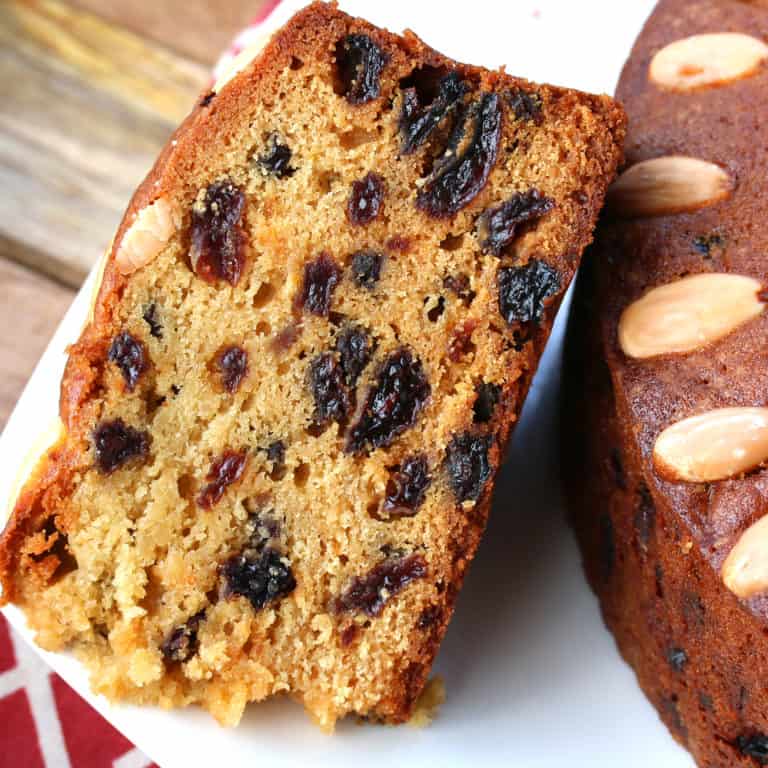
Will the REAL Scottish Dundee Cake Stand Up?
Everyone with glacé cherries sit down. Everyone with mixed spice or gingerbread spices have a seat as well. Anyone with whisky, brandy or rum sit down also…
There are endless varieties of Dundee Cake out there and the vast majority are imposters. But that holds true for many old, traditional dishes that someone somewhere decided to alter and over time the original ingredients became mingled with others until the version that became the most common no longer resembled the original version.
Is that always a bad thing? No. Variations on traditional recipes taste perfectly good. They’re just not…traditional. They’re not the real deal.
In the case of Scottish Dundee Cake the vast majority of the recipes out there are really just an English fruit cake with the almonds across the top to make it “look” like a Dundee cake. But the traditional version of Scotland’s prized Dundee cake is something quite different.
Authentic Scottish Dundee Cake
Besides the flour, butter, sugar, eggs, baking powder and touch of salt, the only other ingredients in an authentic Dundee cake are raisins and/or sultanas, orange zest, almonds, and Seville marmalade. That means no other dried fruits or nuts, not glacé cherries, no gingerbread or other spices, and no whiskey, brandy or rum.
What sets Dundee Cake apart from any others is its featured flavor: Orange. And not just any orange, specifically the sweet-bitter Seville orange with its own unique and characteristic flavor. All of the other ingredients serve to support that flavor and not take away from or dilute it.
What we have in a true Dundee cake is a much lighter and delicately flavored cake that showcases that Seville orange flavor along with the added sweetness of raisins and sultanas, and the additional flavor and delightful crunch of almonds. A true Scottish Dundee Cake hasn’t been altered to taste like the mainstream fruit cakes we all know, instead it has a very unique flavor all to its own.
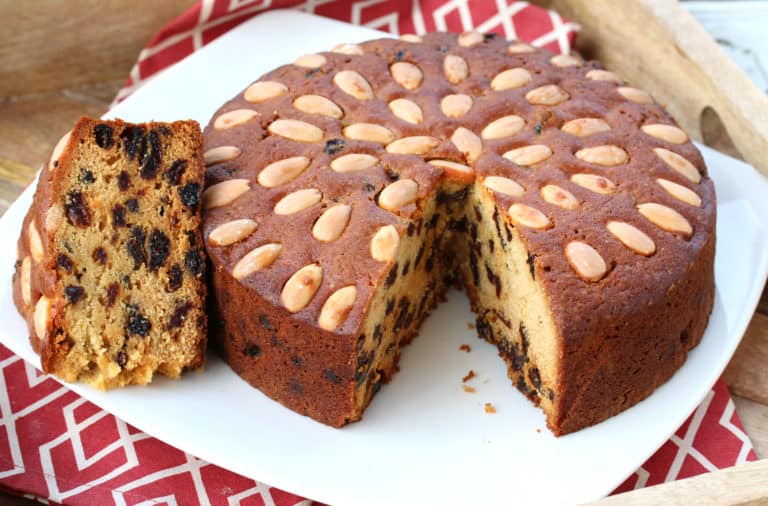
The History of Dundee Cake
There are some varying accounts but food historians believe that the Dundee cake dates back to the 1600’s and is attributed to Mary Queen of Scots (who incidentally is my great+ grandmother on my father’s side. I used to think all of my royal connections made me special until I found out that virtually everybody with European ancestry has royal lines once you get back to a certain point. So depending on how you choose to look at it, that means we’re either all special together or that nobody is special since we’re all…uh…special). In any case, Mary apparently hated glacé cherries (something I inherited from her) and wasn’t fond of the traditional fruit cakes either (same here, unless I’m using homemade candied citrus peel).
So her royal cook made her a cake that simply had raisins/sultanas and almonds in it but also featured a very unique ingredient that would forever set the Dundee cake apart from any other. It featured the subtle but striking flavor of Seville oranges that were being imported into the Scottish port town of Dundee via Spanish merchants sailing up from Spain. The original cake also used Spanish sultanas and almonds. Evidently she liked it because the cook lived to make many more and the cake soon made history.

Fast forward to the 18th century: The Keiller Marmalade Factory in Scotland started making Seville orange marmalade and marketed it in conjunction with the Dundee cake. Ever since then, instead of using Seville orange peel the Dundee cake has been made with Seville orange marmalade. This not only makes Seville oranges more accessible during off season and in other parts of the world, it also contributes the extra sweetness to the otherwise bitter oranges.
Some historians have wondered if it was in fact the Keiller Marmalade Factory who created the first Dundee cake instead of Mary Queen of Scots’ cook. But what we do know for certain is that the credit of using of the Seville orange marmalade goes to Keiller and it may also be that Keiller created the striking and instantly recognizable design of the concentric rings of whole blanched almonds on top of the cake which also add an positively delightful “crunch”.
By the 19th century the Dundee cake became popular throughout the tea rooms of Great Britain and was the dessert of choice for tea-time for both Winston Churchill and Queen Elizabeth II.
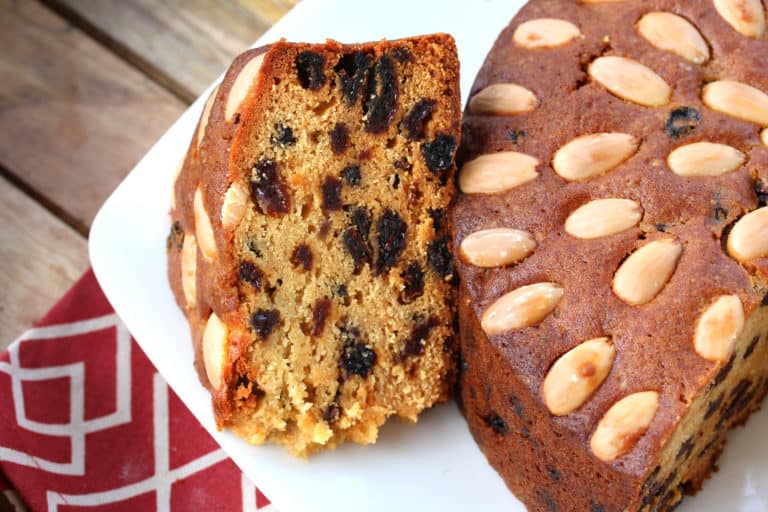
Authentic Dundee Cake Recipe
Let’s get started!
Be sure to use Seville orange marmalade for an authentic-tasting Dundee cake. I brought a few jars back with me from our trip to Scotland last year. I’ve seen Mackay’s Dundee Orange Marmalade at World Market, in some large grocery chain stores (e.g., Albertson’s), speciality stores, and you can find Mackay’s Dundee Orange Marmalade on Amazon. You can also find the original Keiller Orange Marmalade on Amazon. Note, there are other brands of Seville orange marmalade, just pick a good one because they are not all of equal quality.
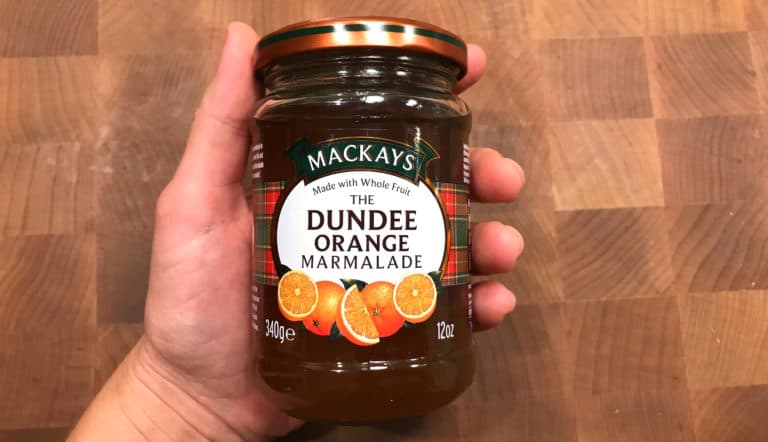
Cream the sugar and butter until pale and fluffy.

Add the eggs, one at a time, along with a teaspoon or so of the flour to prevent curdling.
Add the orange zest and marmalade and beat until combined.

Stir together the flour, baking powder, and salt and almond flour. Add this mixture to the wet mixture and stir gently to combine, being careful not to over-stir.
Add the sultanas and raisins and stir to combine.
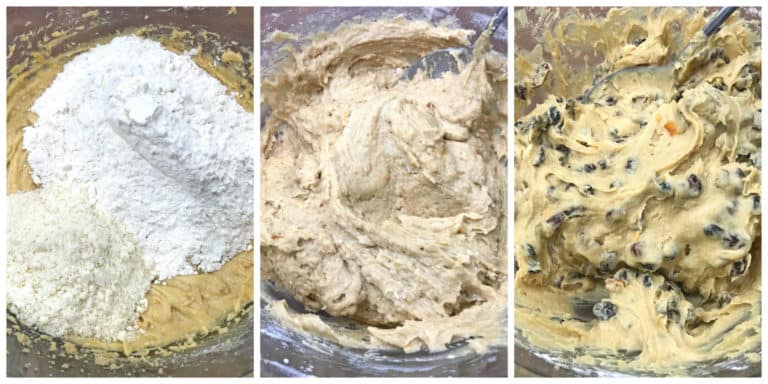
Grease and line an 8×3 inch round cake pan (alternatively a 9 inch round cake pan).
Spoon the batter into the prepared cake pan.
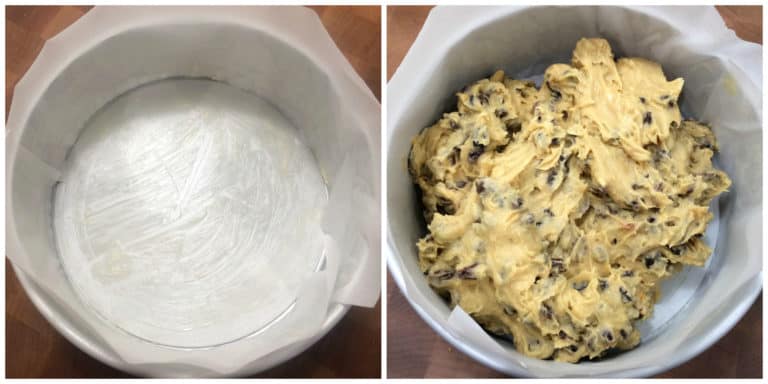
Smooth the top of it using wetted fingertips or the back of a wet spoon.
You’ll need roughly 20 whole blanched almonds for the top. See the “note” in the recipe box for directions on how to blanch the almonds (ie, remove the peels).

Preheat the oven to 300 F.
Arrange the almonds on top of the cake in concentric circles. Position the cake on the middle rack of the oven and bake for 100-120 minutes or until a toothpick inserted into the center comes out clean. If the cake browns too quickly cover it with aluminum foil.
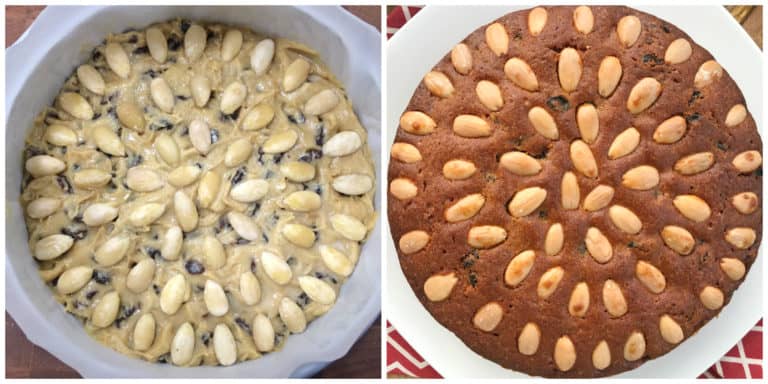
Let the cake cool in the pan for about 10 minutes.
Remove it from the pan and place it on a wire rack to cool completely.
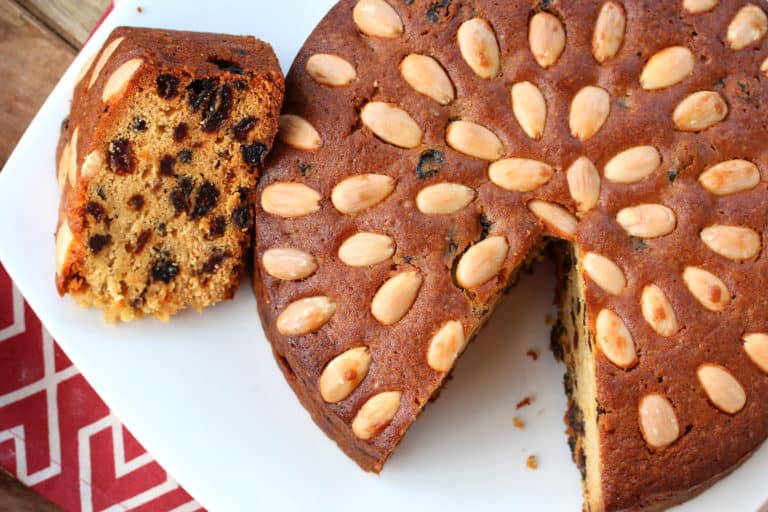
Storage and Freezing
Store the cake in an airtight tin at room temperature. To ensure it stays moist you can wrap it and then put it in the tin. It will keep for about a week.
Dundee cake can also be frozen. Wrap it well and store it in a freezer-safe container or freezer bag and it will keep fro up to 3 months. Let it thaw at room temperature.
Enjoy!
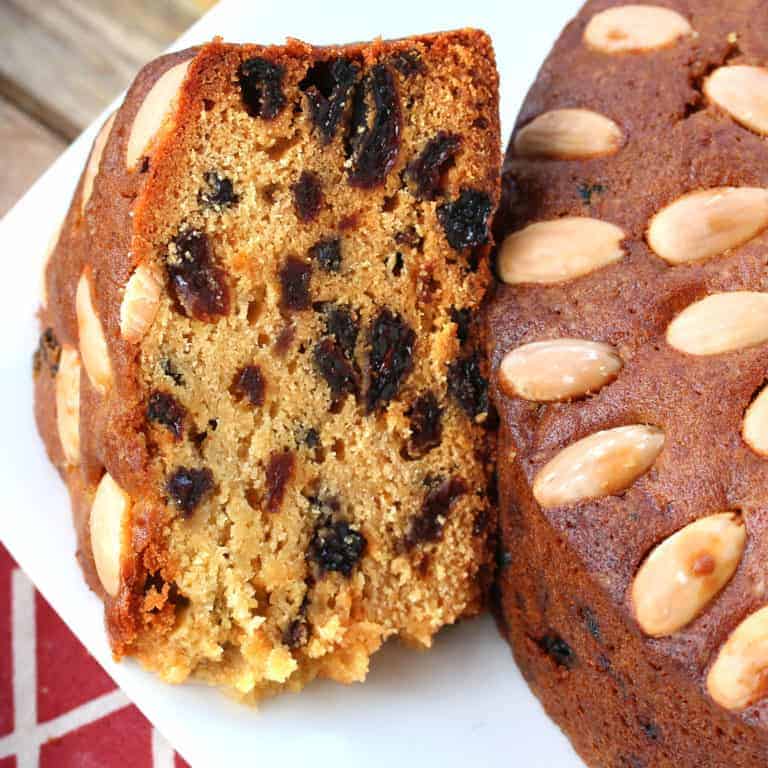
For more traditional Scottish recipes be sure to try my:
Save This Recipe
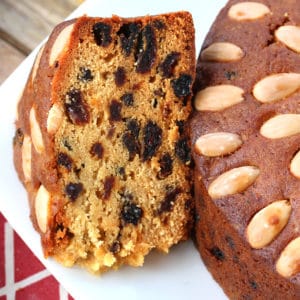
Authentic Scottish Dundee Cake
Ingredients
- 3/4 cup unsalted butter , softened at room temperature
- 1 cup firmly packed light brown sugar
- 3 large eggs
- zest of one orange (Seville if you have it)
- 5 tablespoons Seville orange marmalade
- 1 1/2 cups all-purpose flour
- 1 teaspoon baking powder
- 1/2 teaspoon salt
- 1/3 cup almond flour
- 1 1/4 cups golden raisins/sultanas (dried white grapes)
- 1 1/4 cups raisins
- 20-25 whole blanched almonds (See Note about blanching almonds yourself)
Instructions
- Grease and line a 8×3 inch round cake pan (alternatively a 9 inch round cake pan). Preheat the oven to 300 degrees F (275 F if using convection).
- Cream the sugar and butter until pale and fluffy. Add the eggs, one at a time, along with a teaspoon or so of the flour to prevent curdling. Add the orange zest and marmalade and beat until combined. Stir together the flour, baking powder, and salt and almond flour. Add this mixture to the wet mixture and stir gently to combine, being careful not to over-stir. Add the sultanas and raisins and stir to combine.
- Spoon the batter into the prepared cake pan and smooth the top of it using wetted fingertips or the back of a wet spoon. Arrange the almonds on top of the cake in concentric circles.Position the cake on the middle rack of the oven and bake for 100-120 minutes or until a toothpick inserted into the center comes out clean. If the cake browns too quickly cover it with aluminum foil. Let the cake cool in the pan for about 10 minutes before transferring it to a wire rack to cool completely.
Notes
Nutrition
Originally published on The Daring Gourmet November 25, 2019



















I have never had this but it reminds of fruit cake or panettone, which I love! Can’t wait to give this a try!
This Authentic Scottish Dundee Cake look so cute and yummy!
I’ve never heard of this before! I would LOVE to give it a whirl!
Looks like a wonderful Christmas dessert. I can’t wait to serve this Dundee Cake to my family during the holidays. And, my kids will love that marmalade too on their toast besides in the cake.
I have never enjoyed “Dundee” cake in the past. And now I know why! This cake is delightfully bright with the orange. The fruits and nuts are perfectly paired. THIS is the Dundee cake I should have been eating all along! Thank you!
p.s….your story reminds of the terrible tragedy that has befallen hot crossed buns. So many of the store bought and bakery bought buns are loaded with cranberries, nuts, and topped with cream cheese frosting (loads of it) now instead of just containing raisins and orange zest and a light icing on top. I no longer buy hot crossed buns. :(
Thank you, Betsy, and so true! I’m not at all opposed to altering traditional recipes, I enjoy a lot of the contemporary variations. But there’s something to be said for making room to enjoy the unique characteristics of the traditional versions. In the case of the Dundee cake I agree with you that the original version tastes the best :)
I am angry and disappointed. I was excited to make this recipe as I recently learned that I am 30% Scottish. I even ordered the fancy marmalade from Scotland. I measured my cake pan to make sure it was 8 inches and prepared it with oil and parchment paper. I weighed all my ingredients and carefully followed the instructions. I even blanched the almonds myself. I was a little worried when I placed the ingredients in my cake pan as the batter came to the top. I wish I had listened to that nagging voice that told me to put the batter in a different pan. Now I have batter spilling over the sides. I did put a cookie pan with parchment underneath to catch it. The printed recipe does not show the type of cake pan. It just states to use an 8 inch pan. It really needs to go in a higher springform pan and not a regular cake pan. That information needs to be added to your recipe. I doubt I am the only one who has had this happen. I cannot rate the cake as it is still baking. I will rate your instructions as lousy.
Hi Mary, I sincerely apologize for that, I should have been more clear. I used a 8×3 inch cake pan and have added a note to the recipe that a 9 inch cake pan can be used in place of a 8×3. Again, I apologize for the confusion.
THIS CAKE!!!! Not only we enjoyed every morsel when I first made it, it looks like it is becoming favorite Sunday breakfast for my sugar hating Scottish husband and my 7 years old son. Definitely happy I found Seville marmalade,loved that bitter finish. I had sultanas at home, but did not realize I ran out raisins, so I used dried currants and it turned out amazing!!
That’s wonderful, Natalya, I’m so glad it has been a hit in your family, thank you so much!
That’s wonderful, Natalya, I’m so glad it has been a hit in your family, thank you so much!
If it’s good enough for the Queen, I’ve got to try it. It’s such a stunning dessert.
que pinta tiene este pastel..! trataré de conseguir esta mermelada para probar. Gracias y Felices Fiestas..!
Looks tasty will try it on christmas